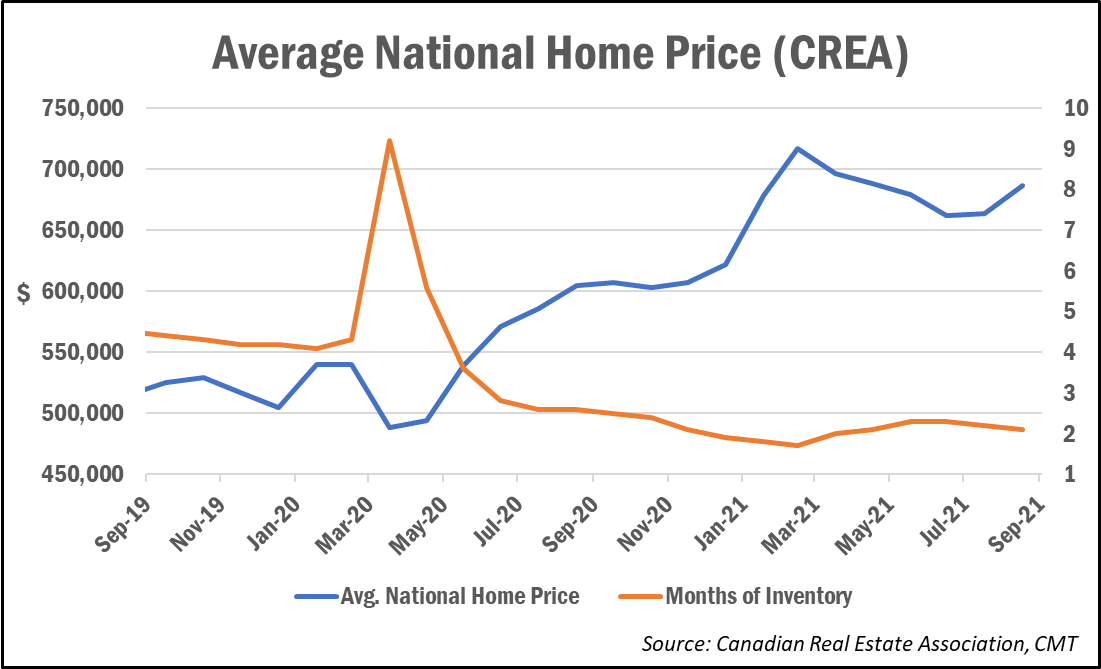Fixed Mortgage Rates Set to Climb Higher as Bond Yields Take Off
Bond yields rocketed higher following today’s Bank of Canada rate decision, making it likely that fixed mortgage rates will continue to rise.
The Bank acknowledged growing inflation concerns, saying the factors pushing prices up are “stronger and more persistent than expected.”
“The Bank is closely watching inflation expectations and labour costs to ensure that the temporary forces pushing up prices do not become embedded in ongoing inflation,” the BoC noted in its rate decision statement.
The Government of Canada 5-year bond yield jumped more than 10 basis points shortly after the announcement, to around 1.43%, before falling back slightly to 1.40%.
The 5-year bond yield, which leads 5-year fixed mortgage rates, is now up over a full percentage point since September 2020.

Fixed rates have already been rising steadily over the past few weeks, and observers say they are likely to take another leg up.
In a tweet, Ron Butler of Butler Mortgage wrote that fixed mortgage rates will be going up again. “Starting Friday, big banks will continue to move fixed rates, likely about 30 bps by the time the dust settles next Friday.”
He added that the growing spread between fixed and variable rates will continue to drive borrowers towards variable rate mortgages.
“The last time 5-year bond yields were this high, deep-discounted 5-year fixed mortgage rates were in the 2.70% range,” housing analyst Ben Rabidoux, founder of Edge Realty Analytics, wrote in his latest report. “That implies about 60 bps of hikes are coming in the next few weeks unless bond yields reverse course.”
Rabidoux explained that the Bank’s recent slowdown in bond purchases, and announcement today that it will end its quantitative easing program altogether, “means that we’ll lose the artificial downward pressure on bond yields going forward,” since that program “had the explicit goal of pushing interest rates lower than they otherwise might be.”
As for variable rates, which are tied to prime rate, which in turn is influenced by the Bank of Canada’s overnight target rate, they could start rising earlier than expected as well.
In the BoC’s statement today, it changed its forward guidance, saying for the first time it could start hiking rates “sometime in the middle quarters of 2022.”
Markets, however, think it could happen even sooner than that, pricing in the first BoC rate hike as early as March. They also see six to seven quarter-point hikes over the next 36 months.
“An April start to tightening looks increasingly likely as long as we see continued progress in the economic and labour market recovery over the next six months,” wrote RBC economist Josh Nye. “Today’s messaging doesn’t go quite as far as the 100 bps of tightening by the end of next year markets were pricing in ahead of the meeting, though the move higher in bond yields and the Canadian dollar shows investors see some validation of that view.”
The Bank of Canada’s Latest Forecasts
Here’s are the key takeaways from the Bank’s rate decision and latest Monetary Policy Report (MPR):
Overnight rate:
- Left unchanged at 0.25%, where it’s been since March 2020.
Quantitative Easing
- The Bank ended its QE (bond-buying) program, as expected.
- The Bank said it will move to a reinvestment phase, meaning, “we will purchase bonds only to replace those that are maturing so that our overall holdings of Government of Canada bonds remain roughly stable over time.”
Inflation
- The bank expects consumer price index (CPI) inflation to average:
- around 3.4% in 2021 (vs. 3% in its July forecast)
- 3.4% in 2022 (vs. 2.4%)
- 2.3% in 2023 (vs. 2.2%)
- “The main forces pushing up prices—higher energy prices and supply bottlenecks—now appear stronger and more persistent than we previously thought,” the Bank said.
GDP forecast
- The Bank now expects annual economic growth of:
- 5.1% for 2021 (vs. 6% in its July forecast)
- 4.3% in 2022 (vs. 4.6%)
- 3.7% in 2023 (vs. 3.3%)









